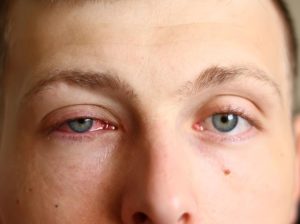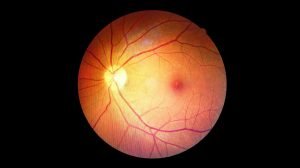What is Pink Eye (Conjunctivitis)?

Pink eye, also known as conjunctivitis, is the inflammation of the transparent membrane that lines the eyelid and eyeball, called the conjunctiva. When the tiny blood vessels in this membrane become swollen and irritated, they become more visible, causing the whites of the eyes to appear pink or red. This condition can result from various causes, including viral and bacterial infections, allergies, or even a blocked tear duct in babies. Although pink eye can be bothersome, it rarely impacts your vision, and effective treatments are available to alleviate its discomfort. Given its contagious nature, early diagnosis and preventive measures can help contain its spread.
Symptoms
Common symptoms of pink eye include:
- Redness in one or both eyes.
- Itchiness in one or both eyes.
- A gritty sensation in one or both eyes.
- Eye discharge that crusts overnight, potentially making it challenging to open your eyes in the morning.
- Excessive tearing.
- Light sensitivity, also known as photophobia.
When to Seek Medical Attention
While pink eye is usually a mild condition, there are serious eye issues that may result in eye redness, pain, foreign body sensation, blurred vision, and light sensitivity. If you experience these symptoms, it’s crucial to seek urgent medical care. For those who wear contact lenses, discontinuing lens use as soon as pink eye symptoms develop is advisable. If your symptoms don’t improve within 12 to 24 hours, schedule an appointment with your eye doctor to rule out a more severe eye infection related to contact lens use.
Causes of Pink Eye
Pink eye can be caused by various factors, including:
- Viruses
- Bacteria
- Allergies
- Chemical splashes in the eye
- Foreign objects in the eye
- In newborns, blocked tear ducts
Types of Pink Eye (Conjunctivitis)
Viral and Bacterial Conjunctivitis
The majority of pink eye cases result from viral infections, particularly adenovirus, but can also be triggered by other viruses such as herpes simplex virus or varicella-zoster virus. Bacterial conjunctivitis can occur alongside cold or respiratory infection symptoms, like a sore throat. Bacterial conjunctivitis can also result from improper contact lens hygiene.
Allergic Conjunctivitis
Allergic conjunctivitis affects both eyes and results from exposure to allergens such as pollen. This exposure triggers the release of inflammatory substances, including histamines, causing symptoms like red or pink eyes, intense itching, tearing, and nasal discharge. Allergic conjunctivitis is not contagious.
Conjunctivitis Resulting from Irritation
Irritants such as chemical splashes or foreign objects in the eye can lead to conjunctivitis. Flushing and cleansing the eye can sometimes cause redness and irritation. Most irritation-related symptoms, including watery eyes and mucous discharge, resolve within a day. However, if symptoms persist or are caused by caustic chemicals, immediate medical attention is essential to prevent potential eye damage.
Risk Factors for Pink Eye
Factors that increase the risk of developing pink eye include exposure to someone with viral or bacterial conjunctivitis, exposure to allergens for allergic conjunctivitis, and the use of contact lenses, especially extended-wear lenses.

Possible Complications
In both children and adults, pink eye can lead to corneal inflammation, affecting vision. Timely evaluation and treatment by a healthcare provider can reduce the risk of complications. Seek medical attention if you experience eye pain, sensation of a foreign object in your eye, blurred vision, or light sensitivity.
Preventing The Spread Of Pink Eye
To prevent the spread of pink eye, practice good hygiene, including:
- Avoid touching your eyes with your hands.
- Wash your hands frequently.
- Use clean towels and washcloths daily.
- Do not share towels or washcloths.
- Change pillowcases regularly.
- Dispose of old eye cosmetics, such as mascara.
- Do not share eye cosmetics or personal eye care items.
Pink eye is no more contagious than the common cold. If good hygiene practices are followed, individuals can typically return to work, school, or child care once their symptoms clear up. However, in situations where close contact with others is involved, it may be advisable to stay home until symptoms have subsided.
Preventing Conjunctivitis in Infants
Newborns are particularly susceptible to bacteria present in the mother’s birth canal. These bacteria, often asymptomatic in the mother, can lead to ophthalmia neonatorum, a severe form of conjunctivitis in infants. To prevent this, antibiotic ointment is applied to newborns’ eyes shortly after birth.
Is it possible to contract pink eye by making eye contact with an infected person?
Pink eye, or conjunctivitis, is typically spread through direct or indirect contact with the eye secretions of an infected person. Simply looking at each other’s eyes without any direct eye secretion contact is unlikely to spread pink eye. However, close contact, such as being in the same room or using the same items that have come into contact with infected eye secretions (like towels or makeup), can increase the risk of transmission. It’s essential to practice good hygiene and avoid sharing personal items to reduce the risk of spreading pink eye. If you suspect you or someone you know has pink eye, it’s a good idea to take precautions to prevent its spread.
Which eye conditions can be mistaken for pink eye?
- Episcleritis: This is an inflammation of the episclera, a clear layer covering the sclera (the white part of the eye). It can cause redness and mild discomfort, resembling pink eye.
- Keratitis: Inflammation of the cornea can lead to eye redness, pain, and tearing, which might be confused with pink eye.
- Iritis/Uveitis: These conditions involve inflammation of the iris and uvea, respectively, and can cause eye redness, pain, and light sensitivity.
It’s essential to consult with an eye care professional for an accurate diagnosis if you’re experiencing eye symptoms similar to pink eye, as they can differentiate between these conditions and recommend the appropriate treatment.
Treatments for Pink Eye
Regardless of the type of pink eye, you can help your recovery by practicing good eye hygiene, avoiding sharing personal items like towels or makeup, and refraining from wearing contact lenses until your symptoms have resolved. If symptoms persist worsen, or if you have severe eye pain, it’s essential to seek medical attention for proper evaluation and treatment.
Are you suffering from pink eye? Don’t delay, seek relief and expert care at the European Eye Center. Our dedicated team is here to provide the best treatment and guidance for your eye health. Contact us now to schedule your consultation and start your journey to brighter, healthier eyes today!







